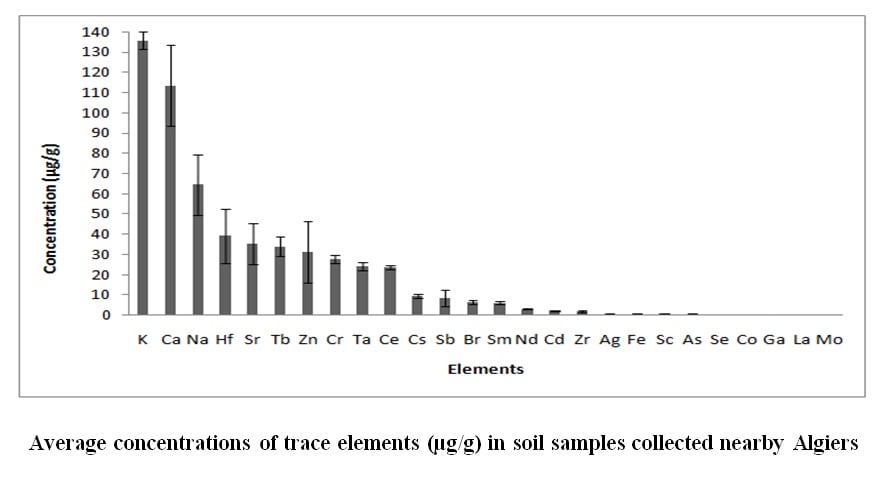An overview of the relative neutron activation analysis performed in the NAA Laboratory of the CRND using NUR reactor
DOI:
https://doi.org/10.57056/ajet.v8i2.121Keywords:
Instrumental neutron activation; analysis (INAA), NUR reactor, Trace elements, Enrichment factors, Anthropogenic pollutionAbstract
Neutron activation analysis is a highly sensitive method for multi-elemental analysis, primarily focusing on the induced radioactivity in atomic nuclei rather than the inherent chemical and physical properties of samples. This approach requires exposing the sample to neutron irradiation, typically conducted within a nuclear reactor. One of the most successful applications of Instrumental Neutron Activation Analysis (INAA) in the vicinity of the NUR reactor pertains to its use in environmental studies. It facilitates the monitoring of the distribution of trace elements (TEs) and the attribution of emission sources by analyzing samples from diverse environmental sources, including soil, air, and bioaccumulative plants collected from various locations near Algiers, Algeria. Since 2010, our laboratory has actively engaged in proficiency tests with WEPAL/IAEA, which has been instrumental in advancing and refining the methods of Neutron Activation Analysis (NAA) employed in this domain. The outcomes derived from these environmental investigations substantiate the presence of more than 30 trace elements. Comparing the enrichment factors (FEs) reveals the contribution of anthropogenic pollution, such as vehicles emitting Sb, Se, and Zn, brickyards releasing As, Co, Cr, Fe, Na, Se, Sc, Ta, and Tb, as well as soil resuspension leading to the release of Br and Zn. Additionally, our laboratory has conducted further studies in the realm of biology using the relative approach of NAA. The primary objective has been to harness the potential of NAA for early diagnosis in cases of cancer and chronic diseases. Consequently, we've examined the trace element composition in the whole blood of both healthy individuals and those afflicted by illnesses. We achieved this by subjecting lyophilized blood samples from adult subjects to simultaneous irradiation alongside an A13-IAEA blood standard. The elemental concentrations were subsequently calculated by measuring gamma rays using a gamma spectrometer. We simultaneously determines the concentrations of ten elements: Rb, Fe, Zn, Na, K, Br, Se, Sr, As and Sc.
References
Hevesy G, Levi H. The action of neutrons on the rare earth elements. Det Kgl Danske Videnskabernes Selskab, Mathematisk-fysiske Meddelelser, XIV. 1936., 5, 1–34.
Hevesy G, Levi H. Action of slow neutrons on rare earth elements. Nature, 1937, 137, 185.
Potts PJ, A 1992. Handbook of Silicate Rock Analysis. Glasgow, Blackie.
Fraga CG,. Relevance, essentiality and toxicity of trace elements in human health. Mol. Asp. Med. 2005;26:235–244. https://doi.org/10.1016/j.mam.2005.07.013.
Karri V, Schuhmacher M, Kumar V. Heavy metals (Pb, Cd, As and MeHg) as risk factors for cognitive dysfunction: A general review of metal mixture mechanism in brain. Environ. Toxicol. Pharmacol. 2016, 48:203–213. https://doi.org/10.1016/j.etap.09.016.
Schomburg L, Köhrle J. On the importance of selenium and iodine metabolism for thyroid hormone biosynthesis and human health. Mol. Nutr. Food Res., 2008, 52:1235–1246. https://doi.org/10.1002/mnfr.200700465.
Zimmermann MB. The Influence of Iron Status on Iodine Utilization and Thyroid Function. Annu. Rev. Nutr. 2006, 26:367–389. https://doi.org/10.1146/annurev.nutr.26.061505.111236.
Tian W. Reactor Neutron Activation Analysis of airborne particulate matter, NAHRES-53. IAEA, Vienna, 2000.
Lei C, Weizhi T, Bangfa N, Yangmei Z, Pingheng W. Preliminary study of airborne particulate matter in a Beijing sampling station by Instrumental Neutron Activation Analysis. Atmos. Environ. 2002,;36:1951–1956.
Gallorini M, Rizzio E, Birattari C, Bonardi M, Groppi AF. Content of trace elements in the respirable fractions of the air particulate of urban and rural areas monitored by neutron activation analysis. Biological Trace Element Research. 1999;71:209-222.
World Health Organization (WHO). Global Health Estimates 2020: Deaths by Cause, Age, Sex, by Country and by Region, 2000-2019. WHO; 2020. Accessed December 11, 2020. who.int/data/gho/data/themes/mortality-and-global-health-estimates/ghe-leading-causes-of-death
Bouhila Z, Mouzai M, Azli T, Nedjar A, Mazouzi C, Zergoug Z, Boukhadra D, Chegrouche S, Lounici H. Investigation of aerosol trace element concentrations nearby Algiers for environmental monitoring using instrumental neutron activation analysis. Atmos. Res. 2015; 166:49–59.
Bouhila Z, Azli T, Boukhadra D, Hadri A, Bayou N, Mazouzi C, Benbouzid S, Lounici H. Assessment of elemental composition in Algiers-Algeria, using instrumental neutron activation analysis on different environmental samples of lichens and tree barks. Journal of Radioanalytical and Nuclear Chemistry. 2021; 329:1301–1311 https://doi.org/10.1007/s10967-021-07891-w.
Saiki M, Sumita NM, Jaluul O, Sobreiro LF, Jacob-Filho W, Vasconcellos MBA. Establishing a protocol for trace element in serum samples from healthy elderly population in São Paulo city, SP, Brazil”. J. Radioanal. Nucl. Chem, 2006; 269:665-669.
Azli T, Bouhila Z, Mansouri A, Messaoudi M, Zergoug Z, Boukhadra D, and Begaa S. Application of instumetal neutron activation analysis method for determination of some trace elements in lichens around three sites in Algiers. Radiochimica Acta, 2021; 109(9): 719–725 https://doi.org/10.1515/ract-2021-1050.

Downloads
Published
How to Cite
Issue
Section
License
Copyright (c) 2023 Zohra Bouhila , Tarek Azli , Abderrezak Hadri , Dallel Boukhadra , Sofiane Benbouzid , Ramy Nouri, Amina Chettah

This work is licensed under a Creative Commons Attribution-NonCommercial 4.0 International License.





